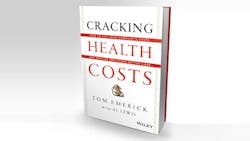Are Wellness Programs Making Your Company Sick?
If a company is measuring the effect of its wellness programs by the bottom line, then the argument could be made that these programs are making the company sick. That’s because the company is losing money on these programs according to Tom Emerick and Al Lewis, authors of Cracking Health Costs.
The authors contend that 90% of wellness programs being sold to companies are “counterproductive at worse and worthless at best." The authors explain that if a company added up all of the diagnosis codes that are linked to wellness programs and add up the medical events in those codes it only accounts for 7% of all medical spending.
“The good news is that subtracting a ton of worthless, counter-productive, and even harmful spending—offset by a small dollop of valuable spending—might be enough to reveal that rather than being an expensive annoyance, your health benefit is a valuable cost-containment and employee health tool,” Lewis and Emerick explain.
The reasons why wellness programs are not effective are based on a few myths, according to the authors. The first is that by managing employee’s health disease and premature mortality will be reduced. That’s not the case, says Emerick and Lewis, as the greatest determinants of health and longevity include genetics, socioeconomic status/finance, job satisfaction, behavioral risks, personal relationships, zip code and luck.
The second myth is that keeping employees out of the hospital using a wellness program is the best way to reduce health spending. The author state that this is not “one shred of evidence that a corporate wellness program can reduce the cost of your health benefits, let alone by more than the cost of the program." (Lewis has written an entire book on this subject Why Nobody Believes the Numbers.)
Furthermore they believe that companies are “likely throwing away large incentives and expensive programs at people who either aren’t going to change in any meaningful way or would change even without incentives.”
To address these concerns they suggest not investing in “gold-plated health plans” as they encourage overuse, overdiagnosis and overtreatment.
The best way for an employer to improve health is to improve health status by creating a workplace culture that employees find less stressful and more satisfying. The authors call this “well being”. Well- Being is its broadest form is a Gallup-Healthways Well-Being Index, that started in 2008 as a way to collect unique data of the U.S population. Using this measurement as it relates to health care costs, a study of medical and pharmacy claims showed that a high well-being score leads to lower hospitalization and emergency room admissions.
“Evidence is pointing to the fact that a better solution to decreasing health care costs is to provide an environment that not only supports employees’ health, such as low stress, but also serves to attract healthy employees,” says Lewis.
Backing this up is Emerick's experience at various Fortune 100 companies. “I saw a pattern when interviewing new hires. The ones who talked about health and medical benefits did not usually make it to the hiring stage, while the ones who were more concerned about how they fit into the organization were usually hired. The point is that a healthy culture, and one the employee feel good about, can lead to better health. “
One method to improve health is to view it in the operational sense similar to other company functions. Emerick points out that he has seen companies use continuous improvement concepts such lean, and six sigma applied to healthcare with favorable results such as lower rates of worker’s compensation occurrences, turnover and absenteeism.
Another way employers can positively impact health care costs is to set up a “Company-Sponsored Center of Excellence.” This is a way to establish direct contracts between employers and clinics and hospitals that have achieved high levels of success in managing specific types of care. Companies can designate certain health-care facilities as Centers of Excellence and offer these as resources to employees resulting in better health outcomes for employees as well as savings.
Wal-Mart is one of the early adopters of this program. “We have identified six renown healthcare systems that meet the highest quality standards for heart, spine and transplant surgerry," explained Sally Wellborn, senior vice president for global benefits for Wal-Mart. “Through these hospital systems our associates will have no out-of-pocket-expenses and a greater peace of mind knowing they are receiving exceptional care from a facility that specializes in the procedure they require.”
There are other steps employers can take to improve employees health that are discussed in the book, including pharmacy benefit management and hospital safety, and the authors explore other myths associated with wellness programs.
At the end of the day what is needed is a closer look at what the company is spending on wellness and measuring effectiveness within their own organization, applying different and smarter ways of utilizing healthcare dollars, and creating a healthier environment.


